Roof Boxes: A buyer's guide
Running into weight or space limitations with your outfit? A roof box could be the answer, delivering vital extra storage without exceeding your MTPLM
Written By Alison Owen
Wife of our technical guru, Terry, Alison needs a bit more space to carry the essentials. Read on as she finds out the best ways to find the most ideal roof box for your needs.
Ever since we plucked up the courage to take our caravan to a public weighbridge we've been worried about the amount of kit we can put on board. Most of the time we manage well, but when it comes to longer trips with the full awning on board we had to make sacrifices. I say 'had', because we've now found the solution in a roof box.
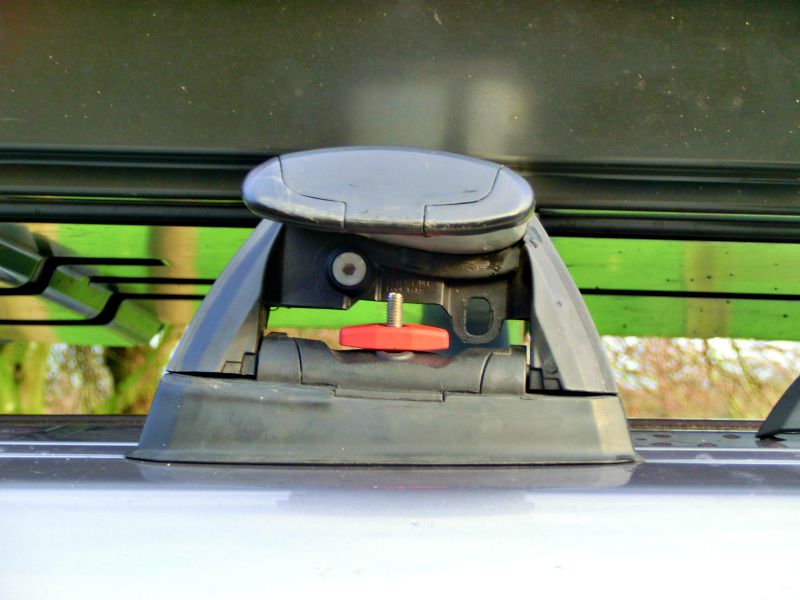
The first thing we had to get our heads around was how the roof box would attach to the car (a Range Rover) which had no roof rails of any description. It was to be the start of a steep learning curve of how roof boxes attach to cars.
A friend has a similar car with a roof box, so we went to see him. It turns out our Range Rovers have six mounting points, each concealed under a plastic, hinged cover. Our friend had used the front four of these to anchor a pair of bars, to which the roof box was firmly attached.
Each mount has a bolt secured by a wing nut and protected by a lockable cover. The bars were aerofoil shaped to minimise wind noise and drag. Problem solved, we just needed a pair of these, and we'd be in business.
Size and shape
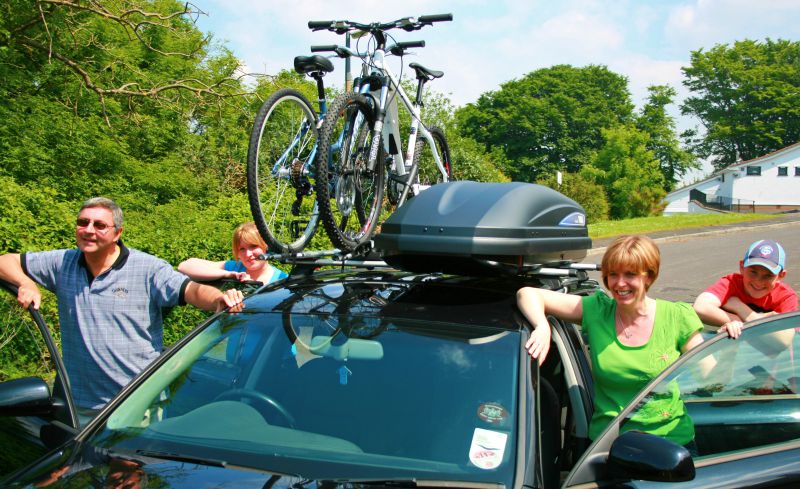
The next consideration was to be the size and shape of the box. A wide box clearly offers more storage and, if it can be opened from either side, is convenient to use. However, if you need to carry other items, including bicycles, on the roof simultaneously, a narrow or medium-width box makes much more sense.
There are normally few constraints on length, but you do need to ensure you can open any tailgate with the roof box in place. If you think this might be a problem, consider allowing the box to overhang at the front a little - you'll never see it when driving.
Make sure the box is at least long enough to accommodate the longest objects you might want to put in it. In our case this had to include our awning poles, and we thought it might be nice if we could get the windbreak in, too.
Even without such items, more length means more space so it's well worth going for a longer box, if it's to be used by a family.
Roof bars
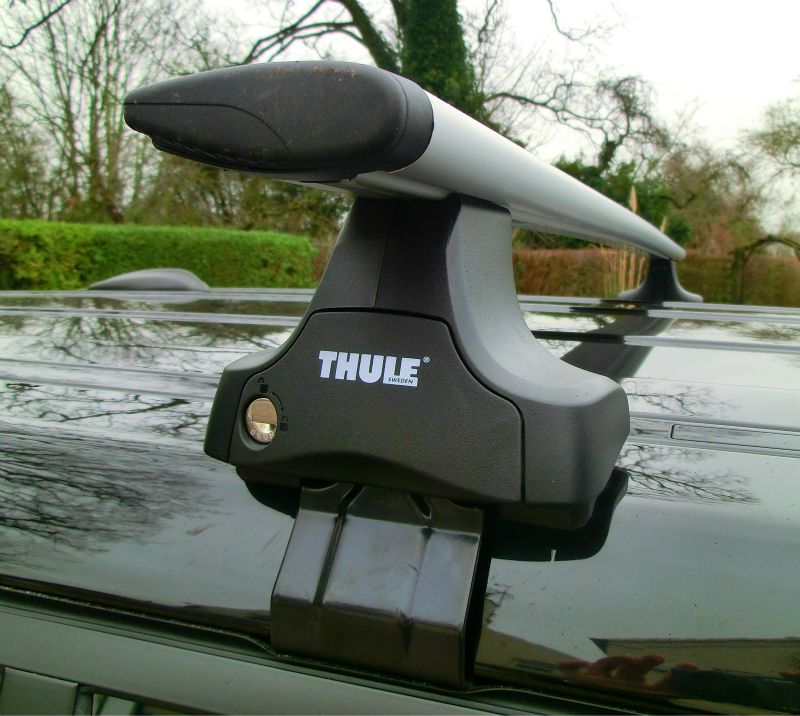
Roof boxes attach to roof bars that go across the car from one side to another. The bars may attach to pre-existing mounting points set in the roof, to existing rails running the length of the roof or simply clamp to the bodywork. A minority of cars have old-fashioned rain gutters that can be used for clamping.
As mentioned earlier, our Range Rover has mounting points already set in the roof, so it seemed this might be the way to go. However, a trip to the excellent website of The Roof Box Company (roofbox.co.uk), backed up by a visit to our local Halfords branch, suggested that the fixing points are set too far back, so long roof boxes would hang over the back of the car and prevent the tailgate being opened.
We weren't totally convinced by this as there were two mounting points near the front as well as four further back. However, we could see that perhaps the front ones were little too far forward and the rear ones too far back for the sort of longer roof box we were considering.
To be fair to Land Rover and other makes with similar mounting points, I should point out that they're designed for roof rails running from front to back.
Some cars, like the editor's old Passat CC, have no roof bar mounting points, so his Thule roof clamps were mounted between the roof swage line and under the top edge of the window frames.
It was a tad tricky to mount, but was as solid as a rock once fixed. He also selected Thule's aerodynamically shaped WingBars which are 55% more drag efficient than their predecessors.
It seemed, therefore, we had two options - to source a set of roof rails and suitable bars or to go for roof bars that clamp to the car's body. As we wished to maintain the clean look of the car for the 90% of the time we'd not be carrying a roof box, we opted for body clamping brackets with aerofoil rails to reduce the noise.
Locking mechanisms
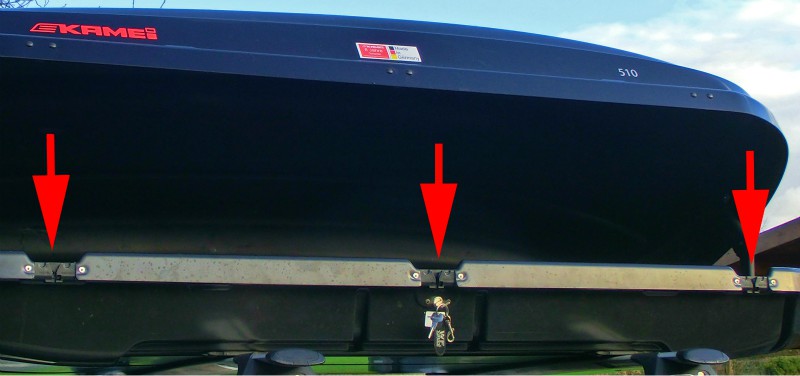
For a roof box lid to be locked securely it may need to be fastened at more than one point. To make this easy, manufacturers have developed central locking systems.
The problem is that, if the roof box is full of bulky items holding the lid up, you may need to push down on the front, middle and rear together, before you can turn the key, which often requires two people.
To overcome this, manufacturers like Kamei have developed 'pull to click-shut' mechanisms whereby you pull down on each point until it clicks shut, then you operate the key.
Weight considerations
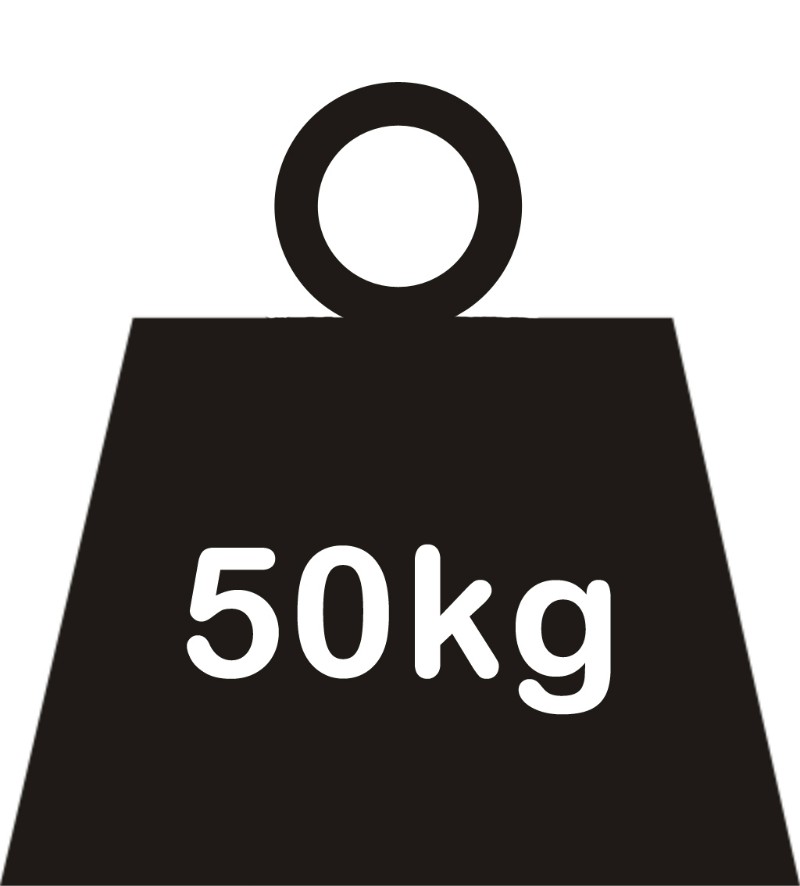 Something we hadn't given much thought to, was how much weight we could put in the roof box and how much it and the roof bars might weigh. Each car model has its own roof-loading limit, generally between 50 kg and 100 kg. Details should be found in the car's handbook.
Something we hadn't given much thought to, was how much weight we could put in the roof box and how much it and the roof bars might weigh. Each car model has its own roof-loading limit, generally between 50 kg and 100 kg. Details should be found in the car's handbook.
Roof boxes with their roof bars weigh in at anything from about 12 kg to 25 kg. This weight must be deducted from the car's roof loading limit before determining the maximum weight to be placed in the roof box. There is also the box's own load limit to consider. This is usually in the range 50 kg to 75 kg.
Capacity
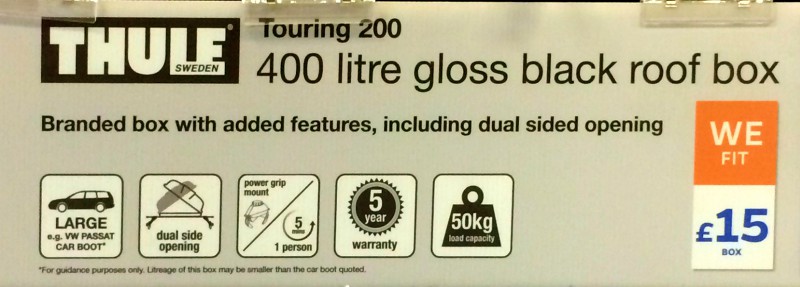
Capacities typically range from 250 litres for a small, half-width box to 600 litres or more for a large, full-width box.
Comparatively, a new VW Golf has a boot capacity of 380 litres and the Volvo V70, a popular towcar, has a boot capacity of 575 litres. Ideal for wet and sandy beach gear, long stuff like windbreaks and beach umbrellas… and annoying, whiny children!
Opening options
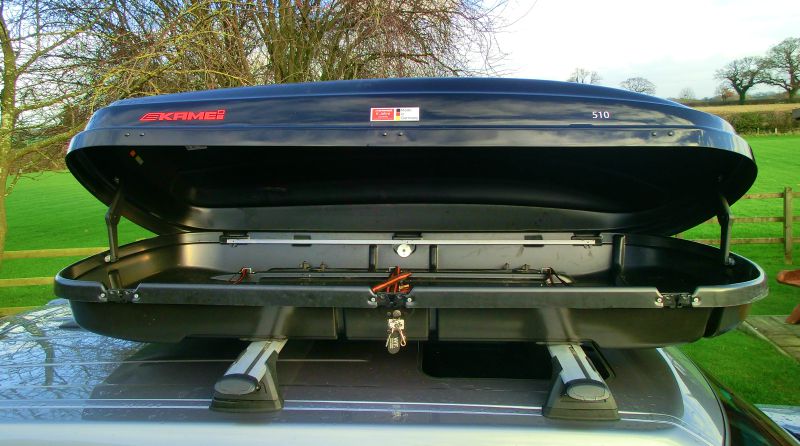
Roof boxes may open from the rear, from one side or from both sides. An advantage of rear and dual side opening is you can access the box from either side, making it easier to attach to the roof bars and to load.
Our choice
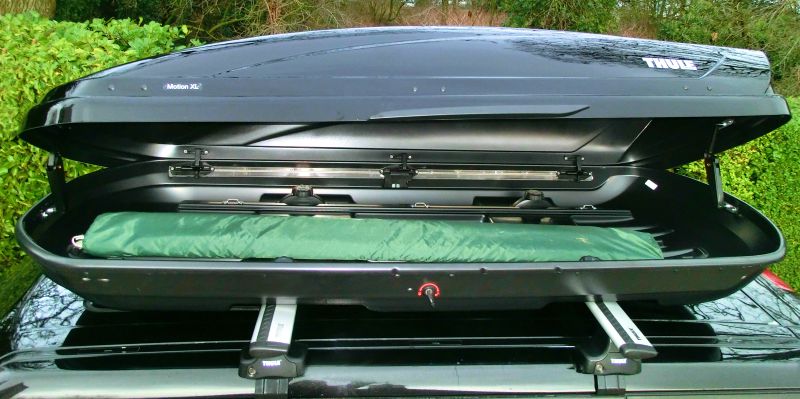 We decided any roof box would have to be big enough for our awning – a full-sized Isabella weighing 51kg with its poles. Clearly, it would need a large box. We thought it might be nice to carry a couple of lightweight bikes on the roof bars together, so we didn't want too wide a box.
We decided any roof box would have to be big enough for our awning – a full-sized Isabella weighing 51kg with its poles. Clearly, it would need a large box. We thought it might be nice to carry a couple of lightweight bikes on the roof bars together, so we didn't want too wide a box.
After much research and deliberation we opted for the Thule Motion 800, also known as the Motion XL. It's a good-quality item with a capacity of 460 litres and a load rating of 75kg. The box weighs in at 19 kg, or 25 kg including the roof bars we chose earlier.
Our car roof's maximum loading is 100 kg, making this a perfect match. It's rated for 130 kmh (80 mph), plenty for us.
And the cost? The box was £439.95. The bars and fixings with locks cost £189.00, making a total of £628.95.
We found fitting the roof bars and roof box to be easy - once we had deciphered the pictorial instructions! Mind you, it did take two of us to lift everything on, but this is common with roof boxes.
The height of our new roof box does make access a little tricky. The caravan step is a big help, or you can stand on the car seats while holding onto a roof bar.
Now the awning can stay in the roof box, out of the way, until we are ready to put it up. As a bonus, the roof bars now give us the option of carrying other items.
If you get stuck with fitting – some systems for cars without roof bars are complex – have a look on YouTube, where pretty much every problem you can think of has a video solution!
Roof box brands
Here's a round-up of the more popular brands you're likely to find on the high street and online.
![]() Atera is a German brand that supplies rack systems to BMW and others. Atera branded roof boxes are made by Hapro (see below).
Atera is a German brand that supplies rack systems to BMW and others. Atera branded roof boxes are made by Hapro (see below).
![]() Auto-Plas has been a supplier of car accessories for over 40 years. In Essex, they currently supply 11 roof box models and associated mounting kits.
Auto-Plas has been a supplier of car accessories for over 40 years. In Essex, they currently supply 11 roof box models and associated mounting kits.
![]() Exodus is a budget range, exclusive to Halfords.
Exodus is a budget range, exclusive to Halfords.
![]() Hapro is a Dutch manufacturer offering five ranges of roof boxes. It is part of the giant VDL manufacturing group that specialises in bus and coach building.
Hapro is a Dutch manufacturer offering five ranges of roof boxes. It is part of the giant VDL manufacturing group that specialises in bus and coach building.
![]() Halfords - here you will find Halfords' own brands along with Thule roof boxes. A fitting service is available.
Halfords - here you will find Halfords' own brands along with Thule roof boxes. A fitting service is available.
![]() Inno is a Japanese manufacturer now selling its wares in the USA and Europe. In the UK selected products are available via The Roof Box Company.
Inno is a Japanese manufacturer now selling its wares in the USA and Europe. In the UK selected products are available via The Roof Box Company.
![]() Kamei was founded in Wolfsburg, Germany in 1952 and made its name specialising in customisation products for the VW Beetle. Kamei produced its first roof boxes in 1998 and has since gained a reputation for quality. Kamei supplies several car manufacturers with own-branded roof boxes including Mercedes and Volkswagen. Its UK importer is The Roof Box Company.
Kamei was founded in Wolfsburg, Germany in 1952 and made its name specialising in customisation products for the VW Beetle. Kamei produced its first roof boxes in 1998 and has since gained a reputation for quality. Kamei supplies several car manufacturers with own-branded roof boxes including Mercedes and Volkswagen. Its UK importer is The Roof Box Company.
![]() Karrite is Thule's budget brand. There are currently six roof boxes from 325 to 580 litres, all at competitive prices.
Karrite is Thule's budget brand. There are currently six roof boxes from 325 to 580 litres, all at competitive prices.
![]() Thule (pronounced 'too-lee') is the world's largest producer of roof boxes and other carrying systems for cars. From Malmö, Sweden, the Thule Group has over 3000 employees at more than 50 production and sales locations all over the world. The company was founded in Sweden in 1942 by the Thulin family.
Thule (pronounced 'too-lee') is the world's largest producer of roof boxes and other carrying systems for cars. From Malmö, Sweden, the Thule Group has over 3000 employees at more than 50 production and sales locations all over the world. The company was founded in Sweden in 1942 by the Thulin family.
![]() Yakima is the USA's largest supplier of car rack systems and roof boxes. The UK distributor is The Roof Box Company which offers four models from Yakima's well-regarded Pro range. Yakima also manufactures the well-known 'Whispbar' range of roof bars.
Yakima is the USA's largest supplier of car rack systems and roof boxes. The UK distributor is The Roof Box Company which offers four models from Yakima's well-regarded Pro range. Yakima also manufactures the well-known 'Whispbar' range of roof bars.
Attachment clamps

Roof boxes attach to roof bars by means of clamps. More often than not these take the form of 'U' bolts of a suitable width for the bars in question. As an alternative, some Thule boxes come with a crab pincer-like clamp that can be operated with just one hand. To attach and release a roof box you need to access the bottom of the box to get at these nuts.
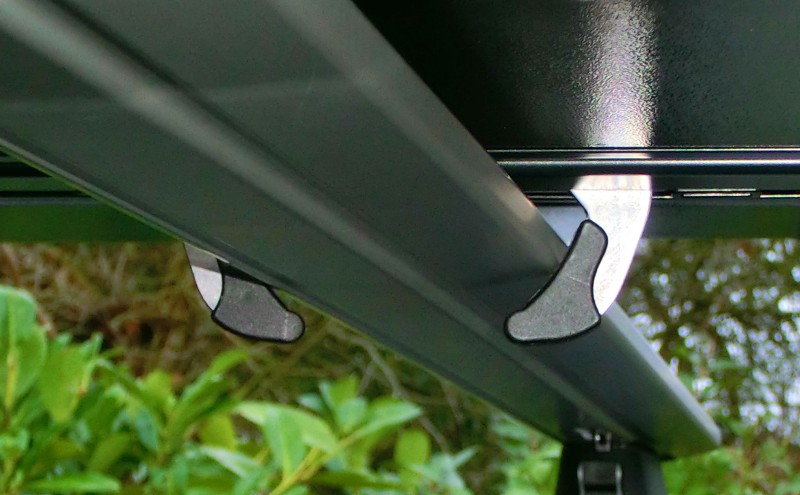
Storage
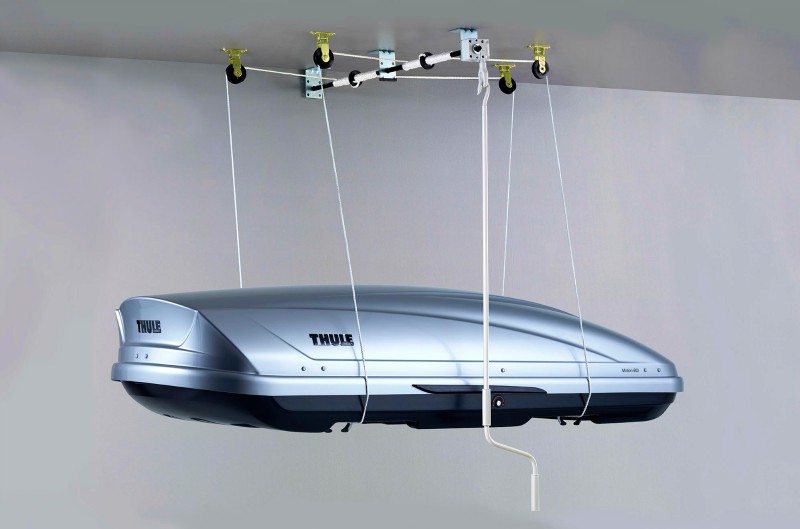
Roof boxes are bulky items and storage can be a problem. The ideal place is above your car in the garage, if there is enough headroom. There are even special hoists to assist you in this process.
Fabric roof boxes
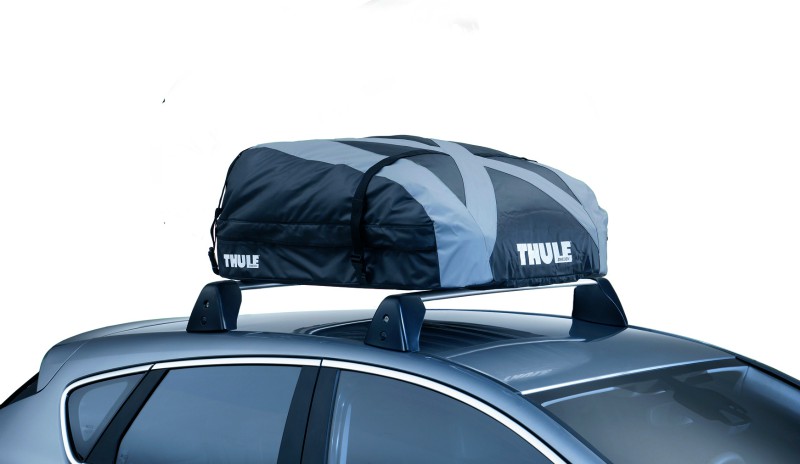
As an alternative to a rigid roof box, you might like to consider a fabric one, like Thule's Ranger 90. It gives good luggage space and turns into a small package that fits in the boot of the car when not needed.
It has a load capacity of 50 kg, but weighs just 7 kg and comes with a quick-mount system for fast fitting. Heavy-duty fabric 'roof bags' are lightweight, cheaper and easier to store
Speed limits
One issue we'd not considered was that a roof box might limit the speed at which we could travel. If towing a caravan you're already limited, therefore no problem but, solo, it might be. Some roof boxes are rated for a maximum of 60 mph so check this out before you buy.
Wind noise and fuel economy
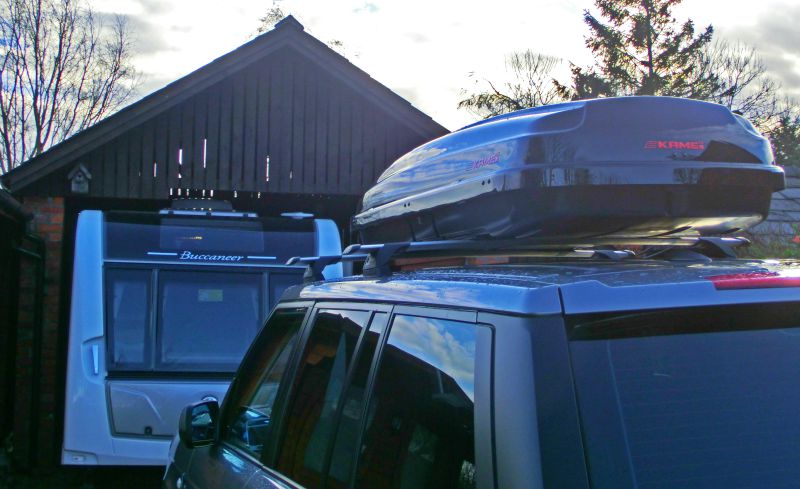
With a well-designed roof box and roof bars, wind noise shouldn't be much of a problem. Bars that have an aerofoil shape are the quietest. Round or square bars may give rise to whistling noises that could become tiresome on long journeys. It pays to choose carefully and to read any user reviews you can find on the internet.
Putting a roof box on your car will cost you a little in fuel economy, typically two to three mpg when solo. However, when you're towing a caravan, you're unlikely to notice any difference.
Conclusions
Roof boxes are a great way of increasing your car's luggage capacity at a fraction of the cost of a new car. Prices range from about £120 for a small box from a budget range, to £600 for a large box from a quality manufacturer. You'll also need to factor in a further £150-£200 for the roof bars and fixings.
A roof box increases the effective height of your car and restricts where you can park it, particularly if you have a tall vehicle. It's a good idea to measure the height to the top of the roof box and write it down somewhere handy for travelling.
Within size limits, most roof boxes will fit most cars, so there's plenty of choice. As with most things, though, you get what you pay for. Cheaper boxes tend to be more flimsy and have fewer features than their more expensive cousins.
If you want dual hinging, gas struts, central locking and keys that can't be removed until the box is securely locked, you'll have to pay a bit more. However, if you won't be using the roof box more than a couple of times a year, all the extras may not be worth it.
It's also worth checking the guarantee period of any roof box you may be considering. These range from just one year to six years. The length of the guarantee is not necessarily related to quality, but it does give some indication of the manufacturer's confidence in its product.
Apart from the obvious advantage of increased carrying capacity, a roof box gives a caravanner the opportunity to carry more weight on the car and less in the caravan.
This can only improve the stability of the outfit. My advice is that, if you've got somewhere to store it, a roof box is a great accessory for any caravanner.








Recent Updates
Caravan showers: all you need to know
In this guide, we’ll discuss the different types of showers, how they work, and how to fit an external shower point to your caravan ...
Caravan towing: all you need to know
Towing a caravan may seem daunting initially, but a few simple tips can make the journey enjoyable and ...
All you need to know about towbars & towballs
Flange, detachable, swan neck, retractable – towbar technology choice is bewildering. Don’t worry. We’ll ...
Caravan WiFi: everything you need to know
Caravan holidays are the ultimate way of getting away from it all, although we sometimes need a link to the ...
Caravan insurance: all you need to know
Navigating the world of caravan insurance can feel like a daunting task. Fear not, as this comprehensive ...
Buying a caravan: what you need to know
Let us guide you through some of the complicated things to think about when first looking at buying a ...
Caravan awnings: a buyers' guide
Caravan awnings are a fantastic addition to any caravan as they are one of the simplest, quickest and most ...
Caravan electrics: avoid tripping out
All caravan owners have overloaded their mains supply at some time. Here’s how to master caravan electrics ...
Caravan heating systems: a quick guide to caravanning warmth
When winter is here, you’ll be glad of a decent caravan heating system if you’re out touring. Here’s how the ...
Caravan damp: a complete guide
There's little more guaranteed to strike fear into the heart of a caravan owner than the word 'damp'. But if ...
Other Articles
Caravan jockey wheels: the definitive guide
A well-functioning caravan jockey wheel can make all the difference to manoeuvring away from the towcar, especially if you don't have a caravan mover ...
Caravan cooking recipes
Caravan cookery inspirational ideas. No need to stress out in the kitchen with these quick and easy ...
Caravan bike racks: a complete guide
Exploring the beautiful surroundings while on a caravan trip is undeniably one of the greatest joys of the ...
Caravan solar panels: all you need to know
Whether you dream of roaming off-grid or just fancy reducing your carbon footprint, fitting solar panels to ...
The ultimate guide to caravan layouts
Choosing the right layout or floorplan of your caravan is an all-important part of the buying process – find ...
A guide to seasonal caravan pitches
Our in-depth guide to finding and securing seasonal caravan pitches on your favourite campsite ...
Caravan weights and payloads: a quick guide
The terminology of caravan weight – MIRO, MTPLM, noseweight, kerbweight, payload, weight plate upgrade – is ...
The ultimate guide to caravan motor movers
Caravan motor movers: everything you need to know about remote control caravan manoeuvring ...
Caravan cleaning: All you need to know
Whether you’re taking the caravan out for the first time or it’s just in need of a spruce up, our guide will ...
18 essential items for camping with your dog
Camping is for the whole family – including our four-legged members. Here's what you'll need to keep your dog ...